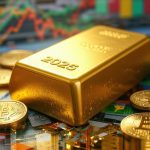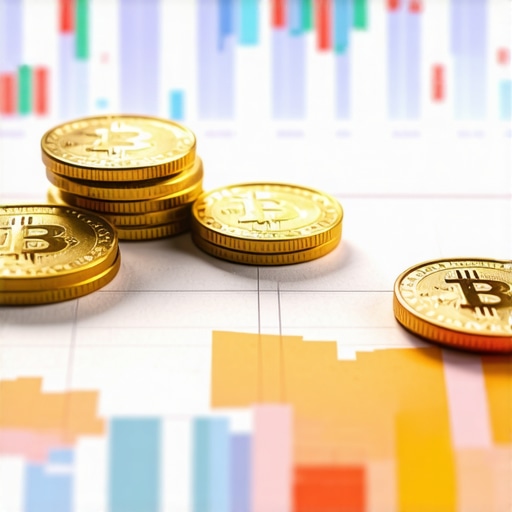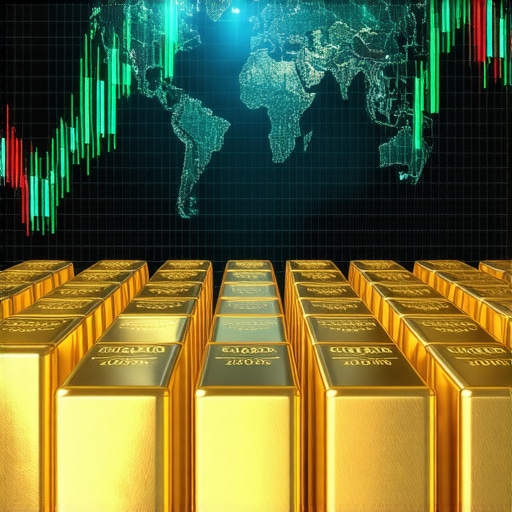Understanding the Nexus Between Global Economic Factors and Gold Price Trajectories in 2025
In the realm of precious metals investment, gold consistently serves as a barometer of economic stability and geopolitical resilience. As we approach 2025, an intricate web of global economic factors—ranging from monetary policy shifts to emerging market dynamics—are poised to influence gold prices in profound ways. This article delves into the sophisticated mechanisms through which macroeconomic variables will steer gold valuation, providing investors with a nuanced, expert-level perspective.
Macroeconomic Catalysts Shaping Gold Price Movements in 2025
How Will Inflation Trends and Central Bank Policies Intersect to Drive Gold Demand?
Inflation remains a central driver of gold’s appeal as an inflation hedge. As inflationary pressures fluctuate globally, particularly within major economies like the US and China, central banks’ monetary policies—such as interest rate adjustments and quantitative easing—will significantly impact gold prices. For instance, aggressive rate hikes could suppress gold’s appeal temporarily, but if inflation persists beyond target levels, gold could rally as a safe haven. Insights from the market forecast reports suggest a cautious optimism for gold’s trajectory amid these macro trends.
Geopolitical Tensions and Their Role in Gold Price Volatility
Geopolitical tensions, such as trade disputes or regional conflicts, tend to elevate gold’s status as a strategic asset. The escalation of such tensions in 2025 could reinforce demand for gold, especially if traditional markets experience volatility. Furthermore, the role of central banks’ gold purchases—particularly from emerging economies—adds another layer of complexity, influencing supply-demand dynamics and price stability.
Supply Chain Disruptions and Mining Output Constraints: An Emerging Concern
On the supply side, disruptions in mining operations, driven by geopolitical instability or environmental regulations, could constrain gold supply. These constraints, coupled with increasing demand, especially from institutional investors, may exert upward pressure on prices. The analytical reports highlight the importance of monitoring supply chain resilience in forecasting future price movements.
Questioning the Role of Digital and Alternative Assets in 2025
Will Gold Maintain Its Safe-Haven Status Amid the Rise of Digital Assets?
With the proliferation of cryptocurrencies and digital assets, experts debate whether gold’s traditional role as a safe haven will diminish or adapt. While digital assets offer new avenues for diversification, their volatility and regulatory uncertainties may reinforce gold’s position as a stable store of value. The evolving landscape warrants a strategic reassessment for investors seeking to optimize their portfolio diversification strategies.
For those interested in diversifying their holdings, exploring options like physical gold investments remains a prudent choice. Engage with industry experts or financial advisors to tailor strategies that align with macroeconomic forecasts.
As we navigate the economic currents of 2025, understanding the layered influences on gold prices will be essential for informed decision-making. Keeping abreast of market indicators, geopolitical developments, and supply-demand shifts ensures a strategic advantage in precious metals investing.
Decoding the Influence of Technological Innovation and Digital Assets on Gold Valuation in 2025
As the financial landscape evolves, technological advancements and the proliferation of digital assets are reshaping traditional investment paradigms. Experts are increasingly analyzing how blockchain technology, cryptocurrencies, and digital tokens influence gold’s role as a safe haven. This intersection raises compelling questions about the future of gold investment and its ability to maintain stability amid rapid technological change.
Can Gold Sustain Its Status as a Safe-Haven Asset in the Digital Age?
This question is at the forefront of strategic investment discussions. While digital assets like Bitcoin and Ethereum offer alternative avenues for wealth preservation, their notorious volatility contrasts sharply with gold’s established stability. However, the emergence of central bank digital currencies (CBDCs) and the integration of blockchain in financial systems could bolster gold’s relevance, reinforcing its position as a hedge against digital currency risks. According to a recent report by market forecast analyses, the convergence of blockchain and precious metals markets could create new pathways for gold’s valuation consistency.
Strategic Tools for Navigating 2025’s Gold Market Complexity
Investors seeking to navigate this complex environment should leverage advanced analytical tools and frameworks. For instance, incorporating macroeconomic indicators with real-time market data through sophisticated models can improve predictive accuracy. Techniques like gold futures analysis and supply-demand modeling are invaluable for aligning investment strategies with emerging trends.
Furthermore, diversifying across various gold investment vehicles—such as physical bullion, ETFs, and mining stocks—can mitigate risks associated with technological disruption. Resources like practical guides for physical gold acquisition provide essential insights into securing tangible assets amidst digital transformation.
What Role Will Geopolitical and Economic Shocks Play in Gold’s 2025 Trajectory?
Geopolitical shocks, economic sanctions, or trade disputes could rapidly alter gold’s demand landscape, particularly as nations seek to diversify reserves and hedge against systemic risks. The strategic purchase patterns of central banks, especially from emerging markets, are critical indicators of future price movements. As highlighted by expert analyses, tracking these institutional behaviors offers a significant edge for investors aiming to capitalize on market shifts.
Engagement with industry reports, market data, and geopolitical risk assessments will be vital for building resilient investment portfolios in 2025. Share your thoughts or experiences with gold’s evolving landscape—your insights could help others navigate this complex yet promising terrain.
Deciphering the Impact of Technological Innovation and Digital Assets on Gold Valuation in 2025
As the digital revolution accelerates, the interplay between blockchain technology, cryptocurrencies, and traditional gold investments becomes increasingly consequential. Experts are analyzing how innovations like tokenized gold and blockchain-based trading platforms are redefining liquidity, transparency, and accessibility in precious metals markets. This evolution prompts vital questions about gold’s capacity to adapt while maintaining its status as a reliable store of value amidst rapid technological change.
Will Blockchain and Digital Assets Reinforce or Undermine Gold’s Safe-Haven Role?
This nuanced inquiry addresses the core of modern portfolio management. Cryptocurrencies such as Bitcoin have often been positioned as ‘digital gold,’ offering decentralization and portability. Nonetheless, their notorious volatility and regulatory uncertainties pose challenges to their role as stable assets. Conversely, the integration of blockchain technology within gold trading—manifested through tokenized gold—could enhance transparency and ease of transfer, thereby strengthening gold’s safe-haven appeal. According to a comprehensive analysis by the Crypto Briefing report, these technological innovations have the potential to create hybrid investment vehicles that combine the stability of gold with the agility of digital assets.
Furthermore, the advent of central bank digital currencies (CBDCs) and their compatibility with existing gold reserves could pave the way for a new era of monetary stability. As noted in a recent publication by the IMF working paper, central banks are increasingly exploring digital currencies as a means to bolster monetary sovereignty, which could influence gold’s strategic role in reserve diversification.
” alt=”Futuristic digital gold trading platform” title=”Futuristic digital gold trading platform” />
This technological interface symbolizes the seamless integration of digital innovations with traditional precious metals, hinting at a future where gold’s valuation is intertwined with blockchain advancements. Such developments necessitate that investors and industry stakeholders stay vigilant about emerging trends and regulatory shifts, which could significantly alter the landscape of gold investment in 2025.
Harnessing Advanced Analytical Tools for Strategic Gold Investment in 2025
Given the fast-evolving environment, leveraging sophisticated analytical frameworks becomes essential. Techniques such as machine learning models, real-time market data integration, and macroeconomic indicator analysis enable investors to forecast price movements with greater precision. For instance, utilizing supply-demand modeling in conjunction with geopolitical risk assessments can illuminate potential price catalysts or downturns.
Platforms like Advanced Gold Trading Strategies offer practical insights into deploying these tools effectively. Diversification across physical gold, ETFs, and gold mining stocks further cushions against unforeseen disruptions, especially those driven by technological or geopolitical shocks.
Engaging with Industry Experts and Market Data for Informed Decision-Making
Active engagement with industry reports, expert analyses, and geopolitical intelligence forms the backbone of resilient investment strategies. For example, monitoring central bank reserve adjustments, as detailed in the central bank reserve report, can offer early signals of market shifts. Collaboration with financial advisors who specialize in precious metals can further refine these insights, ensuring that portfolios are optimized to withstand volatility and capitalize on emerging opportunities.
In conclusion, the convergence of technological innovation, macroeconomic forces, and geopolitical developments makes 2025 a pivotal year for gold investors. Staying informed, leveraging advanced analytical tools, and engaging with authoritative insights will be crucial for navigating this complex landscape successfully. Dive deeper into these strategies by consulting industry experts and continuous learning—your proactive approach can significantly enhance your investment resilience in an uncertain yet promising future.
Emerging Technological Paradigms Reshaping Gold’s Investment Landscape in 2025
As digital transformation accelerates, innovative financial instruments such as tokenized gold and blockchain-enabled trading platforms are fundamentally altering market accessibility and transparency. These technological strides facilitate fractional ownership and instantaneous settlement, appealing to institutional and retail investors alike. Industry leaders like Cointelegraph emphasize that integrating blockchain technology can significantly reduce transaction costs and mitigate counterparty risks, thereby reinforcing gold’s appeal as a secure asset class in the digital age.
Assessing the Interplay Between Global Monetary Policies and Gold Valuation Strategies
In a landscape characterized by monetary policy divergence, central banks’ approaches to interest rates, quantitative easing, and reserve management are pivotal. For example, the potential normalization of monetary policy in major economies may lead to a reevaluation of gold’s safe-haven status. Conversely, accommodative policies or unexpected inflationary shocks could trigger renewed demand for physical gold and ETFs. Financial strategists must leverage macroeconomic models incorporating policy trajectories to anticipate these fluctuations accurately, guided by comprehensive analyses such as those provided by the IMF Working Paper.
How Do Geopolitical and Economic Uncertainties Amplify Gold’s Portfolio Diversification Role?
Heightened geopolitical tensions, trade disputes, and regional conflicts invariably escalate demand for gold as a hedge against systemic risks. The strategic gold acquisitions by emerging economies’ central banks, as documented in recent World Gold Council reports, exemplify this trend. These developments necessitate a dynamic approach to portfolio diversification, integrating geopolitical risk assessments with quantitative risk management tools to optimize exposure and resilience during turbulent times.
Can Artificial Intelligence and Big Data Enhance Predictive Accuracy for Gold Price Movements?
Advanced data analytics and machine learning algorithms are increasingly vital for deciphering complex market signals. By synthesizing macroeconomic indicators, geopolitical events, and supply-demand metrics, AI-driven models can offer predictive insights with enhanced precision. Platforms such as QuantStart highlight how integrating big data analytics into investment frameworks can uncover subtle market patterns, enabling proactive decision-making amidst volatility.
Engage with Cutting-Edge Strategies and Stay Ahead in the Dynamic 2025 Gold Market
To capitalize on these evolving trends, investors should pursue continuous education and leverage sophisticated analytical tools. Engaging with industry experts, participating in specialized webinars, and utilizing real-time market data platforms are essential strategies. For tailored guidance, consulting with financial advisors who specialize in precious metals can provide bespoke strategies aligned with macroeconomic forecasts. Explore resources like Advanced Gold Trading Strategies to refine your approach and secure a competitive edge in the complex 2025 environment.
Expert Insights & Advanced Considerations
1. The Role of Digital Asset Integration
As blockchain technology and tokenization evolve, gold’s role as a safe-haven asset is expanding into digital realms, offering increased liquidity and transparency. Experts highlight that embracing these innovations can optimize portfolio resilience in 2025.
2. Central Bank Reserve Dynamics
Monitoring central bank gold reserve adjustments provides crucial signals for market trends. Strategic diversification should consider these institutional moves to anticipate price fluctuations and capitalize on emerging opportunities.
3. Geopolitical Risks and Supply Chain Stability
Heightened geopolitical tensions may disrupt supply chains, influencing gold prices. Advanced risk assessment tools and geopolitical intelligence are essential for proactive investment strategies in this volatile environment.
4. Technological Innovations and Market Accessibility
Tokenized gold and blockchain-enabled trading platforms are reducing transaction costs and mitigating counterparty risks, reinforcing gold’s market stability amid technological disruption.
5. AI and Big Data in Market Prediction
Leveraging machine learning and big data analytics enhances predictive accuracy for gold price movements. Incorporating these tools into investment frameworks supports smarter decision-making in 2025.
Curated Expert Resources
- IMF Working Paper on CBDCs: Offers insights into how central bank digital currencies influence reserve assets, including gold.
- Crypto Briefing Report on Tokenized Gold: Analyzes blockchain innovations impacting gold liquidity and transparency.
- World Gold Council Reports: Provides data on global gold reserves, demand trends, and supply dynamics essential for strategic planning.
- QuantStart Articles on AI Modeling: Guides on deploying AI for market prediction and risk management in precious metals.
Final Expert Perspective
In 2025, mastering the intersection of technological innovation, macroeconomic analysis, and geopolitical awareness will be crucial for gold investors. The integration of digital assets, advanced predictive tools, and institutional reserve insights not only deepen understanding but also enhance resilience against market volatility. Engage with these resources and continuously refine your strategies to stay ahead in this dynamic landscape. For personalized guidance or to share your insights, connect with industry professionals or participate in specialized forums—your expertise could shape the next chapter of gold investment excellence.










